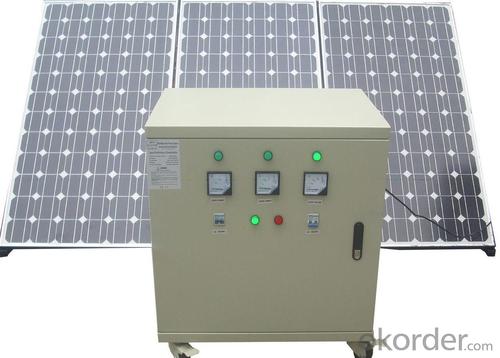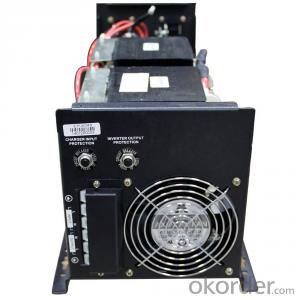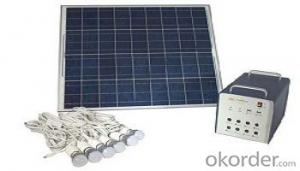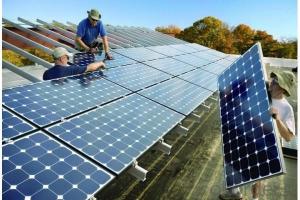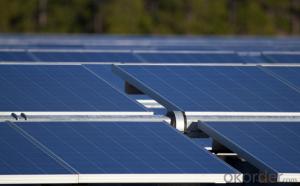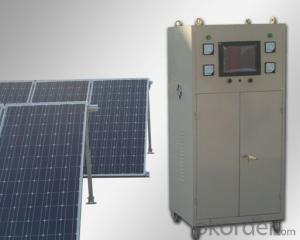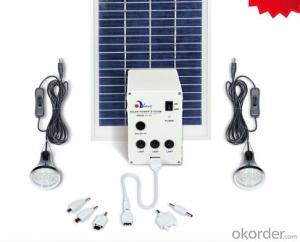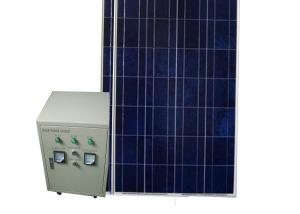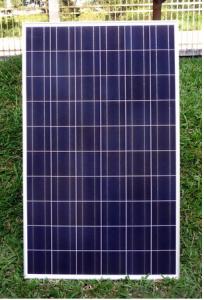Commercial Solar Energy Systems - CNBM Solar Home System CNBM-K5 (500W)
- Loading Port:
- China Main Port
- Payment Terms:
- TT
- Min Order Qty:
- 1 set set
- Supply Capability:
- 1000 sets per month set/month
OKorder Service Pledge
OKorder Financial Service
You Might Also Like
Brief Introduction of Solar Energy System CNBM-K5 (500W)
CNBM Home System-K5 (500W) has a wonderful capacity.It can be used in factory,home,school and other CNBM Home System-K5 (500W) consist of the solar modules,charge controller,inverter and battery banks.
CNBM International is highly recognized by its business partners and clients all over the world and has obtained rapid development under the spirit of win-win .
With CNBM Home System-K5 (500W),
We will carry on the mutual beneficial,innovative and revolutionary trading structure as we did before,create value for our employees,share holders and clients and benefit the whole society in our future development.Please contact us ,if you have interest in CNBM Home System-K5 (500W),don’t hesitate!
The Sketching of Solar Energy System CNBM-K5 (500W)
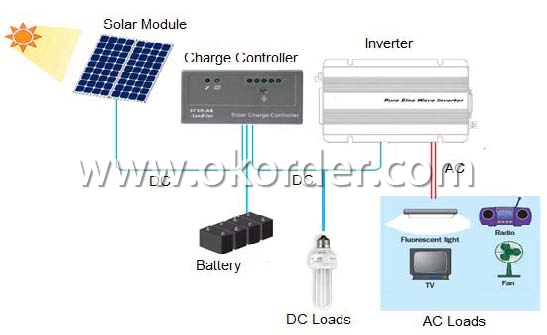
Components of Solar Energy System CNBM-K5 (500W)
PV Array:
Convert sunlight instantly into DC electric power. Formed by the solar modules (also called photovoltaic modules) in accordance with the system requirements for series and parallel.
Solar Charge Controller:
A charge controller may be used to power DC equipment with solar panels. The charge controller provides a regulated DC output and stores excess energy in a battery as well as monitoring the battery voltage to prevent over charge or over discharge. An inverter can be connected to the output of a charge controller to drive AC loads.
Inverter:
Converts DC output power of photovaltaic soalr panels into standard AC power for use in the local off-grid electrical network. It is a critical component in a photovoltaic system, allowing the use of ordinary commercial appliances.
Battery banks:
Stores energy when there is an excess coming in and distribute it back out when there is a demand. Solar PV panels continue to re-charge batteries each day to maintain battery charge.
Technical data of Solar Home System CNBM-K5 (500W) | ||
Inverter | Rated load power | 1000W |
Output wave | Pure sine wave | |
Output voltage | DC 24V | |
Output frequency |
AC:220V | |
Precision of output | 50HZ/60HZ | |
Precision of output frequency | ±6% | |
Solar panel | Pmax | 165W*3PCS |
Vmp | 36V | |
Imp | 4.63A*3 | |
Charger | Charger voltage & current | 24V /10A*3 |
Battery | Capacity | 12V 120AH*2PCS |
Power box | Spray paint iron box,with input,output,ammeter,voltmeter,master swith and so on. | |
Package of Solar Home System CNBM-K5 (500W) | ||||
Part | Size(L*W*H mm) | Weight(kg) | 20’(pcs) | 40’(pcs) |
Power box | 580*520*540 | 60 | 70 Sets | 160 Sets |
Solar panel | 1600*830*90 | 45 | ||
Battery | 420*360*240 | 80 | ||
Factory Picture of Solar Energy System CNBM-K5 (500W)
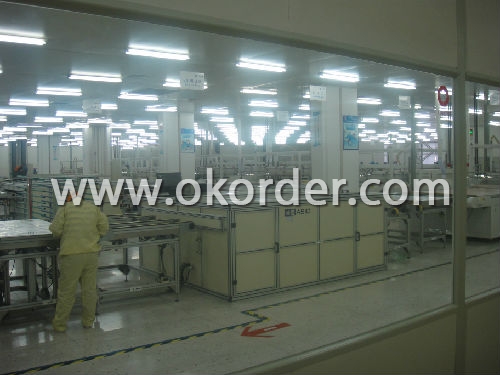
Package Picture of Solar Energy System CNBM-K5 (500W)
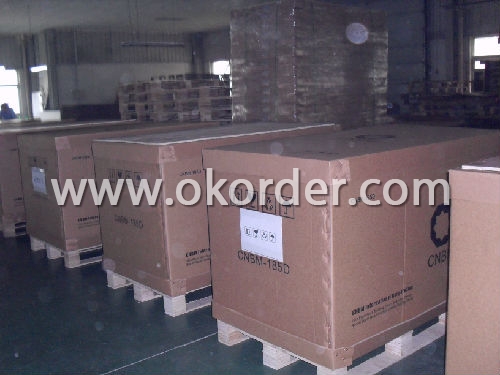
- Q: Is it possible to store excess solar energy for later use?
- Yes, it is possible to store excess solar energy for later use.
- Q: What are the different applications of solar energy systems in transportation?
- Solar energy systems can be used in transportation for various applications, including powering electric vehicles, charging stations, and providing energy for auxiliary systems such as lighting and ventilation in vehicles. Solar panels can be integrated into the design of vehicles or installed on rooftops of cars, buses, and trains to harness solar energy and reduce dependence on fossil fuels. This renewable energy source can help mitigate greenhouse gas emissions, increase energy efficiency, and promote sustainable transportation.
- Q: Can solar energy systems be used in areas with limited water resources?
- Yes, solar energy systems can be used in areas with limited water resources. Solar energy systems primarily rely on the sun's radiation to produce electricity or heat, and do not require significant amounts of water for operation. Unlike conventional power plants that rely on water for cooling and steam generation, solar energy systems can operate without the need for water-intensive processes. Solar photovoltaic (PV) systems, which convert sunlight directly into electricity, do not require water for operation. These systems consist of solar panels that capture sunlight and convert it into electricity through the photovoltaic effect. As a result, they can be installed in areas with limited water resources without any impact on their functionality. Solar thermal systems, on the other hand, use sunlight to heat a fluid, such as water or oil, which is then used to generate electricity or provide heating. While these systems may require some water for cleaning or maintenance purposes, the water requirements are relatively minimal compared to traditional power plants. Additionally, advancements in solar thermal technology have led to the development of dry-cooling systems, which significantly reduce water consumption. Moreover, solar energy systems can be combined with other technologies to further minimize water usage. For instance, solar-powered desalination plants can be used to convert seawater or brackish water into freshwater through a process called reverse osmosis, without relying on traditional energy sources or fossil fuels. This integration of solar energy and desalination can provide clean drinking water in areas with limited freshwater resources, while reducing the strain on water supplies. In conclusion, solar energy systems are well-suited for areas with limited water resources as they operate primarily on sunlight and do not require significant amounts of water for their functioning. The use of solar power can not only reduce greenhouse gas emissions and dependence on fossil fuels but also alleviate the water scarcity issues faced by these regions.
- Q: Can solar energy systems be used in areas with limited space on rooftops due to existing equipment or structures?
- Yes, solar energy systems can be used in areas with limited space on rooftops due to existing equipment or structures. There are various types of solar energy systems available, such as solar panels that can be mounted on the ground or integrated into walls or facades. Additionally, innovative technologies like solar shingles or thin-film solar cells can be used in areas where traditional solar panels may not fit. Therefore, even with limited rooftop space, it is still possible to harness solar energy and benefit from its renewable and sustainable advantages.
- Q: What are the key components of a solar energy system?
- The key components of a solar energy system include solar panels, an inverter, a mounting system, batteries (optional), and a monitoring system.
- Q: Can solar energy systems be used for powering water pumps?
- Yes, solar energy systems can be used to power water pumps. Solar-powered water pumps use photovoltaic panels to convert sunlight into electricity, which can then be used to operate the pump. This makes solar energy an environmentally friendly and cost-effective solution for pumping water in remote areas or off-grid locations.
- Q: Do solar energy systems require a lot of wiring?
- Yes, solar energy systems require a significant amount of wiring. This is because the solar panels need to be connected to each other and to an inverter, which converts the DC electricity produced by the panels into AC electricity for use in homes or businesses. Additionally, wiring is needed to connect the inverter to the electrical panel of the building and to the grid, if the system is designed to export excess electricity.
- Q: What is the payback period for a solar energy system?
- The payback period for a solar energy system is the time it takes for the system to generate enough savings on energy costs to recoup the initial investment. This period can vary depending on factors such as the cost of the system, location, government incentives, and energy usage. On average, the payback period for a solar energy system ranges from 5 to 10 years.
- Q: Can solar energy systems be used in areas with high levels of vandalism or theft?
- Yes, solar energy systems can still be used in areas with high levels of vandalism or theft. However, additional security measures such as installing sturdy fences, security cameras, and alarm systems can be implemented to deter potential thieves or vandals and protect the solar panels and equipment. Additionally, community engagement and education programs can be helpful in raising awareness about the benefits of solar energy and discouraging theft or vandalism.
- Q: Can solar energy systems be used in areas with high humidity?
- Yes, solar energy systems can be used in areas with high humidity. While high humidity can affect the efficiency of solar panels to some extent, modern solar technology is designed to withstand various weather conditions, including high humidity. Additionally, regular maintenance and cleaning of the panels can help minimize any negative impact on their performance.
Send your message to us
Commercial Solar Energy Systems - CNBM Solar Home System CNBM-K5 (500W)
- Loading Port:
- China Main Port
- Payment Terms:
- TT
- Min Order Qty:
- 1 set set
- Supply Capability:
- 1000 sets per month set/month
OKorder Service Pledge
OKorder Financial Service
Similar products
Hot products
Hot Searches
Related keywords



